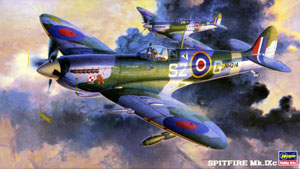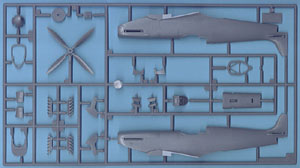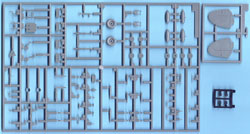Hasegawa 1/48 Spitfire Mk. IXc
By Jim Schubert
 |
History
Really now! If you need a history of any mark of Spitfire, you've no bloody business reading this magazine.
 The Kit
The Kit
Have you noticed that all we ever get in reviews of contemporary Tamegawagram kits is superlatives. You know what? They're deserved! I paid $23.95 retail (plus Washington State's onerous 8.8% sales tax) for my kit at Emil Minerich's Skyway Model Shop in south Seattle. This is not at all expensive when you compare what you get with what you get for more money in the Blue Max Snipe kit reviewed elsewhere in this issue. For your money you get a total of 131 parts on seven sprue trees: five contain 118 parts injection molded, to perfection, with no sink marks, in Hasegawa's standard medium gray styrene, one has nine thin, crystal clear styrene parts and another provides four vinyl collars (you use one to retain the propeller). 22 of the kit's 131 parts are marked, "Parts not for use." in the instructions. This tells us that Hasegawa will be issuing Mk.IXs with different wings as well as, at least, a Mk.VII, a Mk.VIII and a PRXI. If you know your Spits you'll know that the lower case suffix letter in the mark designation defines the wing armament, not the wing tip fitted. If they'll do a new fuselage and canopy they could also easily give us a bubble-topped Mk.XVI (although that wouldn't be much of a conversion for a serious modeler). The XVI, by the way, was identical to the IX except the engine was a US Packard Merlin. A few early XVIs, such as the one illustr ated in this kit's instructions, were built with the standard high rear deck. Subsequently all XVIs featured a cut-down rear deck and a bubble canopy. Most had clipped wings, but a few had the standard wingtip; and, of course, wingtips were sometimes changed in the field just to confuse modelers in later times. Most XVIs had the "e" wing armament. Be careful. Check your references as well as your six.
ated in this kit's instructions, were built with the standard high rear deck. Subsequently all XVIs featured a cut-down rear deck and a bubble canopy. Most had clipped wings, but a few had the standard wingtip; and, of course, wingtips were sometimes changed in the field just to confuse modelers in later times. Most XVIs had the "e" wing armament. Be careful. Check your references as well as your six.
Although the clear parts are thin they may not be thin enough for the hood to sit comfortably over the rear deck if you chose to leave the hood open. And you really should have the hood open to show off the very complete interior. It may be necessary to use a hood cut from a Squadron or Falcon vac-formed part or, failing that, to vac-form your own.
The single, two side sheet of instructions has three folds to make eight "pages" providing a brief history in Japanese and English, a parts map, ten steps of annotated, graphic, assembly instructions, two "pages" setting out two color/markings schemes with color references to the Mr. Color brand, to Federal Standards (FS) and to British Standards (BS) and most importantly (?), these instructions include one set of PYA cautionary notes in nine languages and another set in five languages. These are about as enlightening as AvUsk's warning on some of their products that, "Swallowing this kit, in whole, or in part, may be harmful to your health." Bah! Humbug! Go ahead and swallow it and sue 'em for producing and marketing an inherently unsafe product!
Standards (BS) and most importantly (?), these instructions include one set of PYA cautionary notes in nine languages and another set in five languages. These are about as enlightening as AvUsk's warning on some of their products that, "Swallowing this kit, in whole, or in part, may be harmful to your health." Bah! Humbug! Go ahead and swallow it and sue 'em for producing and marketing an inherently unsafe product!
The very logical engineering of the kit is also very conventional: vertically split fuselage; one-piece lower wing; two upper halves; one-piece tailplanes. They captured the "gulling" of the aft, underside, wing roots perfectly. A small, but very practical detail is the one-piece main wheels/tires with separate brake drums and a choice of three wheel hub faces. This will make getting a nice sharp separation of tire and wheel colors a piece of cake. Another neat touch is the cockpit "floor" insert is curved to look like the belly skin of the airplane, as the real article actually had no floor as such.
 The decals are, typically, excellent Hasegawa products providing, apparently, everything, including many small stenciled notes, to complete the two schemes detailed in the instructions. One for Mk.IXc NH214, "City of Warsaw", of No. 316 (Polish) Squadron and the other for Mk.XVIc TB476, "Ladykiller", of No. 443 Squadron; both in Dark Green and Ocean Gray over Medium Sea Gray. When it comes to Spitfires, there are so many after market decals available for the different marks that you can cobble together just about any markings you want.
The decals are, typically, excellent Hasegawa products providing, apparently, everything, including many small stenciled notes, to complete the two schemes detailed in the instructions. One for Mk.IXc NH214, "City of Warsaw", of No. 316 (Polish) Squadron and the other for Mk.XVIc TB476, "Ladykiller", of No. 443 Squadron; both in Dark Green and Ocean Gray over Medium Sea Gray. When it comes to Spitfires, there are so many after market decals available for the different marks that you can cobble together just about any markings you want.
A pet peeve here: (Pay attention Messrs. kit manufacturers!) With the state of the kit producing art being what it is today, could we please have all control surfaces, and maybe the flaps as well, as separate pieces? Few airplanes have internal control locks. The most common manifestation of this fact is that most elevators droop down against their lower travel-limit stops whilst the airplane is static and unmanned. Very simply this means that today, you cannot build an accurate model, out-of-the-box, from most airplane kits from most manufacturers. Damn! Rudders and ailerons, in these same circumstances, are also frequently slightly displaced from their neutral positions.
Conclusion
This is, as you'd expect, a great kit. It's accurate, logically engineered, perfectly molded and has lots of conversion possibilities. Four minor negatives are that the exhausts could be better, there are no belts to keep the pilot from falling out of his airplane, the cockpit flap door is molded closed and there are no pneumatic lines to the main wheel brakes. The only after market parts I'm going to use on this bird are a seat and exhausts from Ultracast for $6.00 and $4.00 respectively. This Mk.IX kit in 1/48th scale is quite a bit better, in my opinion, than Hasegawa's recent Mk.VIII and IX kits in 1/72nd scale. I am really quite impressed with the quality of this kit.
It may be my personal perversion, preferring odd ball airplanes, that I bought this Mk.IX specifically to kit-bash with the 1994 Gartex-Hasegawa 48th scale Mk.Vb float-Spit in order to build the sole Mk.IX, MX892, fitted with the floats designed and built by Folland for the Mk.Vb project.
References
Oh boy! When citing Spit references it becomes not so much a question of where to start, but, rather, a question of where to stop. If you want only one killer reference, use...
-
Spitfire - The History: E.B. Morgan & E. Shacklady, 634 pages, 1250 B&W illustrations and 16 color pages. Key publishing, Stamford, Lincolnshire, 1987; ISBN 0-946219-109 (Currently available on special sale from Motorbooks, phone
 1-800-826-6600 , under their stock number 131180AE for only $29.95 plus p&p).
1-800-826-6600 , under their stock number 131180AE for only $29.95 plus p&p).
If you really like Spits you ought to beg, borrow, copy or steal.....
-
Calling All Spitfires, A Scale Modeler's Guide To The Spitfire In 1/72 Scale: John R. Beaman, Jr., Self Published, 1973. John addresses every Mark of Spitfire from Mk.I through Mk.24 and includes all the Seafires. Although written for 1/72nd scale it is the best simple, one source definition of Spitfire/Seafire differences from Mk.-to-Mk.
Another very good, comprehensive reference on the Merlin Spits is:
-
The Supermarine Spitfire - Part 1; Merlin Powered: Robert Humphreys, SAM Publications, Bedford, UK (phone 001-44-8707-333373) for ~$26.00.
and.....
-
Aero Detail #27, Vickers Supermarine Spitfire Mk.VI - XVI: no author credited, Dainippon Kaiga, Tokyo, 2000; ISBN 499-22709-7-C0076 (~$40.00)
